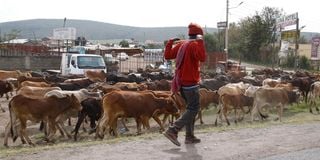Premium
Agriculture CS Mithika Linturi unveils Sh350m plan to protect herders

A pastoralist drives his herd along the Nakuru-Nairobi highway in Nakuru County in search of scarce water and pasture on October 27, 2022.
What you need to know:
- The livestock off-take programme will kick off next week and will see the Kenya Meat Commission (KMC) buy emaciated animals for slaughter to feed the hungry.
- The targeted counties are Tana River, Embu, Garissa, Kitui, Makueni, Meru, Narok, Nyeri, Kajiado, Tharaka Nithi, Taita Taveta, Kwale, and Kilifi.
- Agriculture CS Mithika Linturi said the animals will be slaughtered by KMC and the meat distributed by the National Drought Management Authority to at least 47,000 households.
The government will release Sh350 million towards the purchase of livestock from pastoralists in 13 counties in a move aimed at cushioning communities that are severely affected by the searing drought.
The livestock off-take programme will kick off next week and will see the Kenya Meat Commission (KMC) buy emaciated animals for slaughter to feed the hungry.
The targeted counties are Tana River, Embu, Garissa, Kitui, Makueni, Meru, Narok, Nyeri, Kajiado, Tharaka Nithi, Taita Taveta, Kwale, and Kilifi.
Agriculture and Livestock Development Cabinet Secretary Mithika Linturi said the animals will be slaughtered by KMC and the meat distributed by the National Drought Management Authority to at least 47,000 households bearing the worst brunt of the prolonged drought.
He said the livestock off-take kitty will need to be increased in order to address the immediate needs of the farmers. The CS visited Sajiloni and Isinya livestock markets due to the high number of livestock deaths recorded in the area.
Speaking in Kajiado where he was hosted by Governor Joseph Ole Lenku in Kajiado East and Kajiado Central, Mr Linturi and Livestock Principal Secretary Harry Kimutai came face to face with hundreds of carcasses of livestock in local sale yards.
Heavy losses
The animals, herders explained, died before they could be sold, leaving them ruing heavy losses.
The County Department of Livestock revealed that Kajiado had lost almost half of its one million heads of cattle in the past year and over 700, 000 sheep and goats out of the two million previously.
Mr Lenku announced that his administration had set aside Sh100 million to buy weak animals and was waiting for the assembly’s decision.
“ We shall pay off the farmers for their livestock. We may not buy all of them but at least, it would not be a total loss,” he said.
The governor also called upon schools not to send children away due to lack of food for the learners, saying, the county government has started distributing relief food support to the most affected of the institutions.
In Isinya, CS Linturi and Governor Lenku addressed locals, who lamented that the rate of livestock deaths was overwhelming and that the support from the Government was urgent.
Mr Stephen Moinket, a community leader, took Mr Linturi and his entourage to a “cattle graveyard” where more than 500 carcasses were rotting away.
Mr Linturi said the government will double its efforts to find a long-lasting solution to food insecurity by introducing improved farming technologies and drought-resistant crops in arid and semi-arid areas.
In the short term, the minister pointed out, President William Ruto has ordered for the release of Sh2 billion for the distribution of relief food. The exercise will kick off this weekend and all cabinet secretaries will be involved in the distribution. More than 4.2 million Kenyans in 29 counties are facing starvation.
“As much as we need a permanent solution, we have to put in place interventions to arrest the current situation,” he said.
He explained that offering subsidised fertiliser, lifting the ban on genetically modified organisms (GMOs), and the planned release of huge tracts of land held by government institutions to be used to grow food are some of the long-term strategies.
“The problem we have right now is the provision of food and water to people and pasture to animals so that they do not die,” he said. Mr Linturi lamented that up to 30 per cent of the food produced in the country was being wasted due to post-harvest loss.
“We need to invest in training and education of our farmers on post-harvest handling. This is because poor storage is one of the ways we are losing our produce,” he said. He explained that the National Cereals and Produce Board (NCPB) has built laboratories to test levels of aflatoxin and increased the number of mobile driers so that produce is dried and stored in the right way.
Farmers were being encouraged to use these facilities so as to minimise the losses encouraging the use of the warehouse system for farmers, the CS said.
“There are other bigger driers at NCPB depots where farmers can take their produce and have them dried to the required moisture levels,” Mr Linturi said.






